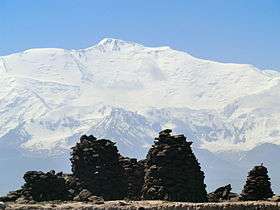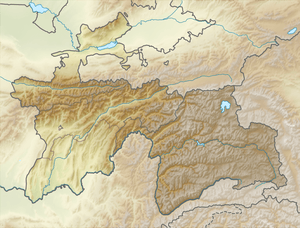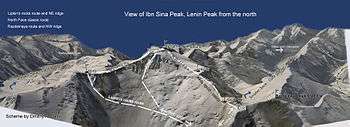Lenin Peak
| Lenin Peak | |
|---|---|
| Ibn Sina Peak | |
 Lenin Peak from Sary Mogol | |
| Highest point | |
| Elevation | 7,134 metres (23,406 ft) [1] |
| Prominence | 2,790 metres (9,150 ft) [1] |
| Listing | Ultra |
| Coordinates | 39°20′33″N 72°52′39″E / 39.34250°N 72.87750°ECoordinates: 39°20′33″N 72°52′39″E / 39.34250°N 72.87750°E [1] |
| Geography | |
 Lenin Peak Location in Tajikistan, on the Kyrgyzstan border | |
| Location | Kyrgyzstan–Tajikistan border |
| Parent range | Trans-Alay Range (Pamirs) |
| Climbing | |
| First ascent | 1928 by Karl Wien, Eugen Allwein and Erwin Schneider |
| Easiest route | rock / snow / ice climb |
Lenin Peak (Kyrgyz: Ленин Чокусу, Lenin Çoqusu, لەنىن چوقۇسۇ; Russian: Пик Ленина, Pik Lenina; Tajik: қуллаи Ленин, qulla‘i Lenin/qullaji Lenin, renamed қуллаи Абӯалӣ ибни Сино (qulla‘i Abûalî ibni Sino) in July 2006[2]), or Ibn Sina (Avicenna) Peak, rises to 7,134 metres (23,406 ft) in Gorno-Badakhshan (GBAO) on the border of Tajikistan and Kyrgyzstan, and is the second-highest point of both countries. It is considered one of the easiest 7000 m peaks in the world to climb and it has by far the most ascents of any 7000 m or higher peak on Earth, with every year seeing hundreds of climbers make their way to the summit.[3] Lenin Peak is the highest mountain in the Trans-Alay Range of Central Asia, and in the Pamir Mountains in Tajikistan it is exceeded only by Ismoil Somoni Peak (7,495 m). It was thought to be the highest point in the Pamirs in Tajikistan until 1933, when Ismoil Somoni Peak (known as Stalin Peak at the time) was climbed and found to be more than 300 metres higher. Two mountains in the Pamirs in China, Kongur Tagh (7,649 m) and Muztagh Ata (7,546 m), are higher than the Tajik summits.
Names
The peak was discovered in 1871 and originally named Mount Kaufmann after Konstantin Kaufman, the first Governor-General of Turkestan. In 1928 the mountain was renamed Lenin Peak after the Russian revolutionary and first leader of the Soviet Union, Vladimir Lenin. In Tajikistan, the peak was renamed again in July 2006,[2] and today it is officially called in Tajik Qullai Abuali ibni Sino (қуллаи Абӯалӣ ибни Сино, Ibn Sina Peak or, alternatively, Avicenna Peak) after Abu Ali ibn Sina (Avicenna). In Kyrgyzstan, the peak is still officially called Lenin Chokusu (Ленин Чокусу, Lenin Peak).
Some sources give Achiktash as the Kyrgyz name for this 7,134 m mountain on the border with Tajikistan,[1][4] but it seems that Achiktash, or more properly Achik-Tash, is the name of a plateau and a base camp at an elevation of 3,600 m on a popular northern climbing route to Lenin Peak, which starts in the southern Kyrgyz city of Osh, a day's drive north of the border.[5]
Climbing history and routes

Initial exploration of this part of Central Asia occurred in the period 1774–82. Arguably the first recorded travel through the region is the involuntary journey of the slave Filipp Efremov (an ethnic Russian), who escaped from slavery in Bukhara. He crossed the Fergana valley, then via Osh, the Chigirik Pass and Terekdavan Pass he reached the Kashgar and finally came over the Karakorum. He was the first European who crossed the Alai Mountains.[7][8]
Scientific expeditions to the Alai Mountains began in 1871, when Alexei Pavlovich Fedchenko discovered the Trans-Alai (Zaalayskiy) Range and its main peak. The first geographical expedition which came nearest to the base of the future Lenin Peak in the early 20th century was arguably the expedition of Nikolai Leopol'dovich Korzhenevskiy.
In September 1928, three mountaineers -the Germans Eugen Allwein and Karl Wien, and the Austrian Erwin Schneider- from a Soviet-German scientific expedition, made the first attempt to reach the highest point of the Trans-Alai Range, which at that time had the name Kaufman Peak.
They started climbing upstream of the Saukdara river along the South slope of Trans-Alai Range also Trans-Alay Range. From the river head they continued climbing along the Greater Saukdara Glacier towards a saddle at an elevation of 5820 m (this saddle is also known as the Krilenko Pass). On September 25, 1928 they started climbing from the saddle along the NE Ridge and at 15.30 they reached the summit. At the time, Kaufman Peak was the highest summit reached by men.
The title Lenin Peak was first applied to the highest point of the Trans-Alai Range in the same year (1928). When it was renamed after Lenin it was believed to be the highest point in the USSR.
On September 8, 1934, at 16:20 Kasian Chernuha, Vitaly Abalakov and Ivan Lukin, three members of a Soviet expedition, reached the summit at an elevation of 7,134 metres (23,406 ft). Their attempt lasted for four days with three camps (5700 m, 6500 m and 7000 m). The expedition started climbing from the Achik-Tash canyon in the Alai valley. The summit attempt itself was started along the Western ice slope of the Lenin glacier. They continued climbing along the North Face, passing the rocks that were later given the name Lipkin's Rocks. At the end of the second day they reached the crest of the NE ridge at an elevation of about 6500 m. During the following day and a half they climbed along the NE Ridge and, utterly exhausted, reached the summit.
The third ascent was three years later, in 1937, when eight Soviet climbers under the direction of Lev Barkhash reached the summit by the same route. This was at the beginning of mass political repressions in the Soviet Union and many of the most prominent Soviet climbers, including Lev Barkhash, were brought to trial.
Subsequent attempts to climb Lenin Peak could not begin until 1950, when the USSR began to recover from the Second World War. On August 14, 1950, twelve climbers (V. Aksenov, K, Zaporojchenko, Y. Izrael, V. Kovalev, A. Kormshikov, Y. Maslov, E. Nagel, V. Narishkin, V. Nikonov, V. Nozdryuhin, I. Rojkov) under the direction of Vladimir Racek reached the summit for the fourth time.
All three Soviet expeditions including Racec's expedition of 1950 were by almost the same route via the NE Ridge.[9]
The route which now is known as the classic route, via the Razdelnaya Peak and NW Ridge, was first climbed in 1954 by the team of Soviet climbers under the direction of V. Kovalev (P. Karpov, E. Nagel, V. Narishkin, V. Nozdryuhin).
.jpg)
In 1960, a group of eight Soviet climbers made a successful direct climb along the North Face (15.08.1960).[6]
There are 16 established routes, nine on the southern side and seven on the northern slopes. The peak is quite popular with climbers due to its easy access and some uncomplicated routes. However, the peak is not without its share of disasters. In 1974, an entire team of eight female climbers died high on the mountain in a storm.[10]
An avalanche triggered by an earthquake killed 43 climbers in 1990.[11]
As it is now, considering the existing infrastructure and BC/ABC locations, there are three most attractive routes from the North (approximately indicated on the Scheme): Lipkin's rocks route and NE Ridge; the classic North Face route; the route via Razdelnaya Peak and the NW Ridge.[6]
References
- 1 2 3 4 Peaklist.org listed here as Pik Achiktash (ex. Lenina) retrieved 21-09-2011
- 1 2 Government Resolution No. 297, July 4, 2006, Dushanbe (Tajik); for Russian text see.
- ↑ Lenin Peak on summitpost.org retrieved 21-09-2011
- ↑ Achiktash: a tourist attraction
- ↑ Achik-Tash camp in Kyrgyzstan on the way to Lenin Peak (Russian)
- 1 2 3 Lenin Peak Expedition. Climb Lenin Peak
- ↑ Ф.С. Ефремов."Девятилетнее странствование и приключения в Бухарии, Хиве, Персии и Индии и возвращение оттуда через Англию в Россию" изд. Санкт-Петербург 1786
- ↑ Ефремов (филипп Сергеев)
- ↑ http://www.skitalets.ru/books/pik_lenina/
- ↑ "The 1974 Russian womens' tragedy on Peak Lenin". Retrieved 19 July 2013.
- ↑ Clines, Francis X. (July 18, 1990). "Avalanche Kills 40 Climbers in Soviet Central Asia". The New York Times. Retrieved 2010-03-14.
External links
- Lenin Peak on summitpost
- Description district Lenin Peak, climbing routes on Lenin Peak
- Alternative 3D map of climbing routes
- Climbing in Kyrgyzstan